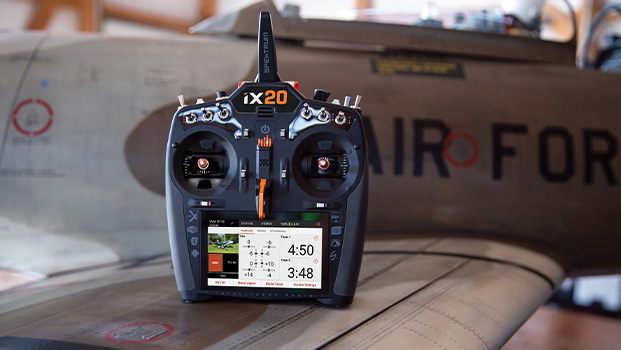SPEKTRUM™ DSMX™ TECHNOLOGY
TRUE EVOLUTION.
The Spektrum™ brand launched the 2.4GHz RC revolution. Since then, millions of hobbyists worldwide have embraced 2.4GHz technology as the way to race and fly. Spektrum leads the way again with DSMX™ technology—the world's first wideband, frequency-agile 2.4GHz signal protocol and the most advanced spread spectrum RC technology.
The DSM in DSMX stands for Digital Spectrum Modulation and is what creates pure digital control providing an impenetrable radio link immune to all types of interference.
A SOLID FOUNDATION: WIDEBAND DSSS
The foundation DSMX is built on is the same as DSM2™ - the superior on-channel interference resistance and coding gain of wideband DSSS (Direct Sequence Spread Spectrum). Compared to the narrowband technology used in other 2.4GHz transmitters, Spektrum DSMR™ and DSM2 signals are far less likely to suffer crucial data loss in the event of on-channel interference. Think of a wideband 2.4GHz signal as a river and a narrowband 2.4GHz signal as a stream. It takes much more interference to stop a river than a stream.
The big reason wideband is so robust is coding gain. Essentially, this means that the unique coding in a DSM2 or DSMX wideband signal allows it to be heard well above the noise of surrounding 2.4GHz signals without requiring any more power. In fact, a Spektrum wideband signal can achieve as much as 3X the range of its narrow-band competition using the same amount of power.

THE 'X'-TRA BENEFIT OF AGILITY
What DSMX™ adds to the tried-and-true wideband technology of DSM2 is the extra interference protection and faster reconnection times of frequency agility. But DSMX isn't just another frequency hopping system. It is wideband agile.
DSMX frequency shifts are coordinated using the most advanced FHSS (Frequency Hopping Spread Spectrum) algorithm ever seen in an RC application. Unlike other FHSS transmitters that all hop in the same fixed patterns, every DSMX transmitter has its own unique frequency shift pattern calculated using its GUID (Globally Unique Identifier). And each pattern uses just 23 channels in the 2.4GHz spectrum.
By adding the agility of unique frequency shifts to the superior interference resistance of a wideband signal and limiting those shifts to a smaller portion of the 2.4 band, DSMX transmitters provide on-channel interference protection that is simply second to none. The result is quicker reconnection times and superb response in the noisiest 2.4GHz environment.
3D SPREAD SPECTRUM
In addition to its wideband DSSS foundation and smarter FHSS protocol, DSMX users enjoy a third dimension of signal protection that DSM2 users have always enjoyed. Only Spektrum full-range receivers offer the patented advantage of MultiLink™ dual-path redundancy. When combined with the superior wideband power and frequency agility of DSMX, MultiLink gives RC pilots the fastest, most reliable 2.4 RC technology available in any signal environment.
FREQUENTLY ASKED QUESTIONS
JUST HOW GOOD IS DSMX?
In multiple tests, 100 DSMX systems were operated simultaneously for extended periods of time. During these tests not a single case of RF link loss, latency increase, or control degradation was experienced or recorded. DSMX is constantly randomly changing the operating channel, making it nearly impossible to get interference from other 2.4gHz devices.
IS DSM2 AND DSMX EQUIPMENT COMPATIBLE?
Yes. DSM2 transmitters are forward compatible with DSMX receivers, and DSMX transmitters are backward compatible with DSM2 receivers. And because DSM2 and DSMX share the same wideband DSSS foundation, all Spektrum users will enjoy superior range, speed, and precision whether they're using DSM2 equipment, DSMX equipment or a combination of both. But you will not have the advantages of worry-free frequency agility when running a DSMX receiver or transmitter in DSM2 mode.
WHY SHOULD I UPGRADE TO DSMX?
In today’s world, there are countless devices transmitting a signal, causing even the most remote environments to be saturated with 2.4gHz signals. DSMX is designed to operate effectively in these over-saturated RF environments, allowing for users the peace of mind that their signal will not be degraded by other devices such as Wi-Fi, GPS, Bluetooth and more. For the most solid and worry-free connection, we encourage anyone running DSM2 to upgrade to DSMX.
CAN I BIND MY SPEKTRUM SURFACE TRANSMITTER TO A SPEKTRUM AIR RECEIVER (OR VICE VERSA)?
No, Air and Surface protocols are coded differently so that they perform well in those environments. An AR### is the indicator for Air protocol DSMX and DSM2 systems, SR### is for Surface Protocol DSMR and DSM2 systems.
WHAT IS THE DIFFERENCE BETWEEN A SPEKTRUM DSMX TRANSMITTER DEVELOPED FOR THE EU AND THOSE DEVELOPED FOR THE REST OF THE WORLD?
The European Union (EU) enacted more stringent regulations on the 2.4gHz band that took effect in June of 2016. These regulations required all 2.4gHz devices to use specific types of Frequency hopping that the DSM2 modulation does not meet. For that reason, EU versions of DSMX transmitters will not work with DSM2 receivers whereas DSMX transmitters for the rest of the world (i.e., US, Canada, Australia, etc.) will bind and operate in DSM2 mode.
